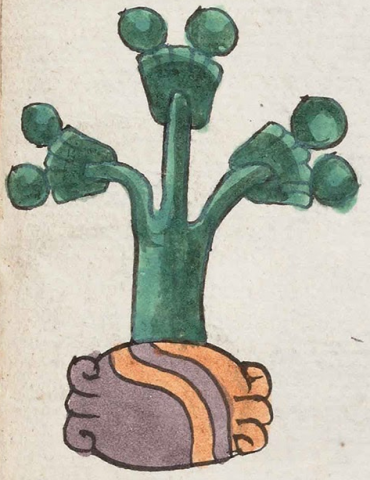Tetzapotitlan (Mdz53r)
This compound glyph for the place name Tetzapotitlan has two principal visual elements: a stone (tetl) at the bottom and, above that, a tree, the (tzapotl). The stone is the standard horizontal oval shape with curling ends and alternating purple and terracotta-orange wavy stripes. Perhaps the stone is meant to refer to a specific type of tzapotl that has an especially hard fruit. The tree has a leader and three branches, all painted in two tones of green. At the end of each branch is a clump of foliage and, emerging from that, two small ball shapes (probably meant to be the fruits). The locative suffix (-titlan) is not shown visually, but perhaps the landscape provide a semantic locative.
Stephanie Wood
Stephanie Wood
teçapotitlan.puo
Tetzapotitlan, pueblo
Stephanie Wood
c. 1541, or by 1553 at the latest
Stephanie Wood
Tezapotitlan, árboles, frutas, piedras, nombres de lugares

te(tl), stone or rock, https://nahuatl.wired-humanities.org/content/tetl
tzapo(tl), a fruit tree, the sapota (or zapote in Mexican Spanish), https://nahuatl.wired-humanities.org/content/tzapotl
-tlan (locative suffix), place, https://nahuatl.wired-humanities.org/content/tlan
Codex Mendoza, folio 53 recto, https://digital.bodleian.ox.ac.uk/objects/2fea788e-2aa2-4f08-b6d9-648c00..., image 118 of 188.
The Bodleian Libraries, University of Oxford, hold the original manuscript, the MS. Arch. Selden. A. 1. This image is published here under the UK Creative Commons, “Attribution-NonCommercial-ShareAlike 3.0 License” (CC-BY-NC-SA 3.0).





